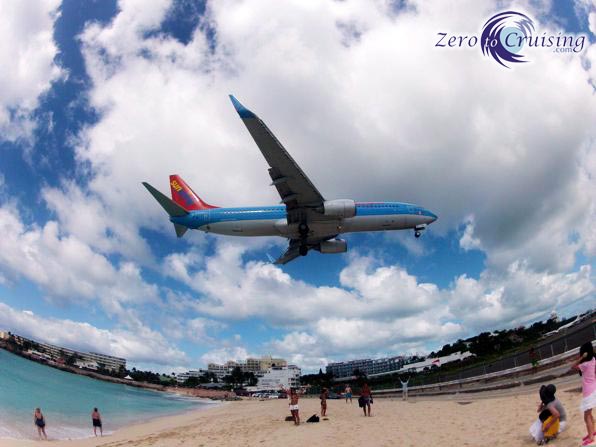Our longest passage?
Three hundred and twenty miles. For those who have done multi-week ocean crossings, this distance is but a tiny jump. For the two of us though, it would represent our longest passage to date, assuming that we were to complete it in one go.
Three hundred and twenty miles is the distance from Bequia, where our boat now lies, to St. Martin, where we plan to sail towards this morning. Note the use of the word “towards” as opposed to “to.” In a sailboat, one does not sail to a destination. Rather, one heads towards a location and hopes that Mother Nature will allow landfall at the desired spot. Many things could happen to prevent this but, in this case, we have a good weather forecast and a favorable sailing direction. With luck, the two of those things will work together to allow us to make the passage in one jump. If not, we’ll stop elsewhere and you’ll likely hear from us sooner. If the conditions for traveling remain suitable though, we’ll just keep on truckin’.

Last year we spent Christmas morning at Maho Beach, St. Martin.
Perhaps we’ll be able to visit there on New Year’s Day this year.
Curious about how long a passage like this would take us? We generally base our estimates around a speed of 5 knots. However, if we can sail faster, we will obviously arrive at our destination a lot quicker. For example:
- 320 nm @ 4.5 knots = 71 hours
- 320 nm @ 5.0 knots = 64 hours
- 320 nm @ 5.5 knots = 58 hours
- 320 nm @ 6.0 knots = 53 hours
As you can see, a little increase in speed has a big effect and in this case, it means the difference between being underway for 2 nights or 3 nights. Obviously, we would prefer it to be only two so, to increase our chances of sailing faster, we have scrubbed our boat’s bottom so that it is super clean and we have swapped our little self-tacking jib for our big 150% genoa. We expect that both of those things will pay off for us. Wish us luck and we’ll see you on the other side.
Note: We will endeavor to keep our Spot tracker running for the duration of the passage but as always, if it stops, do not freak out. It is not a safety device for us. We have a real EPIRB that serves that function. Also, we will be far enough offshore that there is little chance of us obtaining an internet signal. We’ll do our best to make up for the lack of posts when we make landfall.



Safe passage! I hope all goes well. And a little more wind so it’s two nights.
Your wishes came true for us.
Happy sailing, God speed and Happy New Years!
The Campbell’s
Thank you! It’ll be New Years in SXM now!
Your more seasoned sailors now and taking each step as you should, maybe next you guys will be talking about Hawaii… Love your blog and all the work you put into it, everyday I wake up and the first thing I do is check to see your update. I’ll be waiting for your next one… Have a great sail and kiss Rebecca everyday.
Sorry we missed a couple of days, Terry. Sadly there was no wifi 30-40 miles offshore. As for the kisses, EVERY day!
I’m sure I speak for many when I say we look forward to hearing about your trip. Hope you find favorable winds and seas and enjoy the passage.
Winds? Good. Seas? Well, 1 out of 2 is not bad, right?
Safe passage! And Merry Christmas!
Thanks, Gerry. Merry Christmas to you too.
Been sailing for 10 hours according to SPOT. 40-50 hours more to go! Long passages like these have always intrigued me. I’ve always dreamed of shooting down the East coast to Key West in one or 2 hops from Cape May sarting October 20. Thats about 1100 miles by hugging the coast the whole time and being in the Ocean so at an average pace of 5knts thats 9-10 days of straight sailing. Then take my sweet time trudging back. Of course this would not be my first pasage- that would suck! But when I’m more experienced this would be great. I would have 7-8 months of cruising the US. However, I might spend most of my time in the Bahamas/Key West. Love those areas.
A long passage would be so much easier with just one more crew member!
Wow. You know, leaving from the right coast is just such a different ball of wax.
No kidding. It makes all the difference in the world.
Buena suerte!
Gracias!
I wish you fair winds and peaceful seas.
I would love to have good wind AND peaceful seas. Sadly they never seem to come together.
Looks like you averaged 6 plus. Good one! I hope it was as beautiful a sail as I envisioned during the last two days!
It seems like the average was 6.5. We had a few slow moments which knocked the average down. There was a lot of time spent going much quicker than that.
Not sure if you calculated those numbers manually or used a tool for it ?
Anyway I learned those calculations also when attending sailing school. But when starting to developing apps for iOS I decided to make a tool for handling this and many other calculations and conversion for us sailors.
The calculation done in this post would be this one in my app:
http://jjc.dk/home.nsf/files/FindTime1024.png/$File/FindTime1024.png
Just enter distance and speed and it calculates the time.
The app is on App Store:
https://itunes.apple.com/app/marine-tool/id587744217?mt=8
Very cool, Jens. Thanks for sharing.